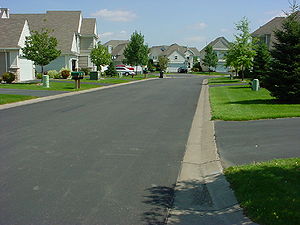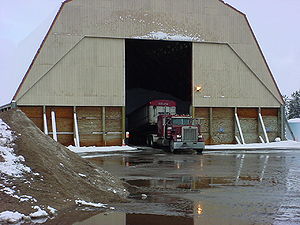
Difference between revisions of "Pollution prevention"
m |
|||
| Line 5: | Line 5: | ||
[[File:Narrow street example.jpg|thumb|300px|alt=Photo of Eagle Valley - Woodbury Mn example of narrow street|Photo of Eagle Valley - Woodbury Mn example of narrow street]] | [[File:Narrow street example.jpg|thumb|300px|alt=Photo of Eagle Valley - Woodbury Mn example of narrow street|Photo of Eagle Valley - Woodbury Mn example of narrow street]] | ||
| − | Residential pollution prevention practices are household and neighborhood activities that prevent or reduce the contamination of stormwater. Residential pollution prevention practices prevent or reduce stormwater contamination from sources such as yards, driveways, sidewalks, and household products. | + | Residential pollution prevention practices are household and neighborhood activities that prevent or reduce the contamination of stormwater. Residential pollution prevention practices prevent or reduce stormwater contamination from sources such as yards, driveways, sidewalks, and household products. |
<p>These practices are often simple, low cost behavioral changes that improve subwatershed water quality by minimizing the introduction of pollutants including sediment, nutrients, metals, bacteria, trash, oil, and toxins.</p> | <p>These practices are often simple, low cost behavioral changes that improve subwatershed water quality by minimizing the introduction of pollutants including sediment, nutrients, metals, bacteria, trash, oil, and toxins.</p> | ||
| − | <p>Each of these practices are highly suitable and effective in cold climates. | + | <p>Each of these practices are highly suitable and effective in cold climates. Each practice varies in it's ability to control pollutants generated from residential land uses. A variety of methods may be used for each of these practices. See [[Pollution prevention#Photo credits|Photo Credits]] and [[Pollution prevention#References|References]] for further information</p> |
{{:Residential practices pollutant controls}} | {{:Residential practices pollutant controls}} | ||
Revision as of 17:12, 23 January 2013
The 2008 version of the Stormwater Manual (Version 2) contains polution prevention fact sheets for residential, municipal and commercial/industrial land uses. Material from those fact sheets comprises the information contained on this page. To link to the original document in Microsoft Word format, click File:Pollution Prevention.docx.
Residential Practices
Residential pollution prevention practices are household and neighborhood activities that prevent or reduce the contamination of stormwater. Residential pollution prevention practices prevent or reduce stormwater contamination from sources such as yards, driveways, sidewalks, and household products.
These practices are often simple, low cost behavioral changes that improve subwatershed water quality by minimizing the introduction of pollutants including sediment, nutrients, metals, bacteria, trash, oil, and toxins.
Each of these practices are highly suitable and effective in cold climates. Each practice varies in it's ability to control pollutants generated from residential land uses. A variety of methods may be used for each of these practices. See Photo Credits and References for further information
This table shows a review of residential pollution prevention practices and the extent to which they control pollutants. Source: modified from the Center for Watershed Protection.
Link to this table
| Practice | Stormwater Pollutants Controlled | ||||||
|---|---|---|---|---|---|---|---|
| Sediment | Nutrients | Metals | Bacteria | Trash | Oil | Toxins | |
| Fertilizer and Pesticide Management | Uncontrolled | Significantly Controlled | Uncontrolled | Uncontrolled | Uncontrolled | Uncontrolled | Significantly Controlled |
| Litter and Animal Waste Control | Uncontrolled | Significantly Controlled | Uncontrolled | Significantly Controlled | Significantly Controlled | Uncontrolled | Uncontrolled |
| Yard Waste Management | Moderately Controlled | Significantly Controlled | Uncontrolled | Slightly Controlled | Slightly Controlled | Uncontrolled | Uncontrolled |
| Household Hazardous Waste Control | Uncontrolled | Slightly Controlled | Significantly Controlled | Uncontrolled | Uncontrolled | Significantly Controlled | Significantly Controlled |
| Alternative Product Use | Uncontrolled | Uncontrolled | Uncontrolled | Uncontrolled | Uncontrolled | Uncontrolled | Significantly Controlled |
| Better Car and Equipment Washing | Moderately Controlled | Significantly Controlled | Moderately Controlled | Uncontrolled | Uncontrolled | Moderately Controlled | Moderately Controlled |
| Better Sidewalk and Driveway Cleaning | Significantly Controlled | Moderately Controlled | Moderately Controlled | Uncontrolled | Moderately Controlled | Moderately Controlled | Slightly Controlled |
| Better Sidewalk and Driveway Deicing | Moderately Controlled | Slightly Controlled | Slightly Controlled | Uncontrolled | Uncontrolled | Uncontrolled | Moderately Controlled |
| Proper Pool Discharge | Uncontrolled | Uncontrolled | Uncontrolled | Uncontrolled | Uncontrolled | Uncontrolled | Slightly Controlled |
| Septic Tank Maintenance | Slightly Controlled | Significantly Controlled | Uncontrolled | Significantly Controlled | Uncontrolled | Uncontrolled | Slightly Controlled |
| Exposed Soil Repair | Significantly Controlled | Moderately Controlled | Slightly Controlled | Slightly Controlled | Uncontrolled | Uncontrolled | Uncontrolled |
| Native Landscaping | Significantly Controlled | Significantly Controlled | Slightly Controlled | Slightly Controlled | Slightly Controlled | Uncontrolled | Uncontrolled |
| Healthy Lawns | Significantly Controlled | Moderately Controlled | Slightly Controlled | Slightly Controlled | Uncontrolled | Uncontrolled | Uncontrolled |
We anticipate eventually including information for specific pollution prevention practices. For now, you can access the pollution prevention fact sheets from the original Stormwater Manual using the following link: File:Pollution Prevention.docx
Residential pollution prevention methods.
Link to this table
| Practice | Method | Image |
|---|---|---|
| Fertilizer and pesticide management 1 | Reduce or eliminate the need for fertilizer and pesticides by practicing natural lawn care, planting native vegetation, and limiting chemical use; follow Minnesota Statutes Chapter 18C and federal regulatory requirements on fertilizer and pesticide storage and application if used. | |
| Litter and Animal Waste Control 1 | Properly dispose of pet waste and litter in a timely manner and according to local ordinance requirements. | |
| Yard Waste Management 1 | Prevent yard waste from entering storm sewer systems and water bodies by either composting or using curbside pickup services and avoiding accumulation of yard waste on impervious surfaces; keep grass clippings and leaves out of the street. | |
| Household Hazardous Waste (HHW) Control 1 | Ensure that hazardous waste, including paints, stains, solvents, cleaning products, used motor oil, antifreeze, and pesticides, are disposed of properly by participating in a County household hazardous waste collection program; properly store hazardous waste items. | |
| Alternative Product Use | Use less harmful products including alternative cleaning solutions, pesticides, fertilizers, automotive and paint products to reduce the amount of toxic substances released into sewer systems. | |
| Better Car and Equipment Washing 1 | Wash cars less often and on grassy areas using phosphorus free detergents and non-toxic cleaning products or use commercial car washes to prevent dirty wash water from flowing to storm sewer systems and water bodies. | |
| Better Sidewalk and Driveway Cleaning 1 | Sweep sidewalks and driveways and dispose of sweepings in the trash instead of using hoses or leaf blowers to clean surfaces. | |
| Better Sidewalk and Driveway Deicing 1 | Reduce or eliminate the need for deicing products by manually clearing sidewalks and driveways prior to deicer use; use environmentally-friendly deicing products when possible, apply sparingly and store properly if used. | |
| Proper Pool Discharge 1 | Check local ordinances for pool water discharge requirements; pool water should be discharged to sanitary sewer systems or held for a week or more without addition of chlorine prior to spreading over pervious areas to prevent stormwater contamination. | |
| Exposed Soil Repair 1 | Use native vegetation or grass to cover and stabilize exposed soil on lawns to prevent sediment wash off. | |
| Native Landscaping | Reduce turf areas by planting native species to reduce and filter pollutant-laden runoff and prevent the spread of invasive, non-native plant species into the storm sewer system. | |
| Healthy Lawns | Maintain thick grass planted in organic-rich soil to a height of at least 3 inches to prevent soil erosion, filter stormwater contaminants, and absorb airborne pollutants; limit or eliminate chemical use and water and repair lawn as needed |
Municipal Practices
Municipal pollution prevention practices are public operation and maintenance activities and ducational efforts implemented by municipal staff that prevent or reduce the contamination of stormwater.
Municipal pollution prevention practices prevent or reduce stormwater contamination from public sources such as streets, parking areas, maintenance vehicles, storm and sanitary sewers, dumpsters, swimming pools and other potential stormwater hotspots. These practices improve subwatershed water quality by minimizing the ntroduction of pollutants including sediment, nutrients, metals, bacteria, trash, oil, and toxins. Each of these practices is highly suitable and effective in cold climates. Table 12.PREV.3 indicates the pollutants controlled by various municipal pollution prevention practices while Table 12.PREV.4 describes some of the methods used for each of these practices. See Chapter 13 for further discussion of potential stormwater hotspots. See Photo Credits and References for further information.













